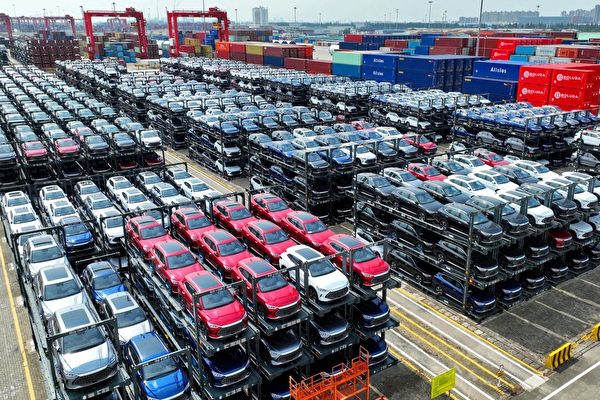In recent years, China’s automotive industry has seen rapid development, with increasingly eye-catching exterior designs. However, underlying issues in terms of quality, safety, and institutional aspects remain hard to conceal. Huang Guocheng, a professional in the domestic automotive industry, pointed out in an interview that compared to international brands, Chinese vehicles lag behind in terms of performance, safety, and durability. He attributed these shortcomings to institutional orientation and systemic corruption.
After graduating from university in 2004, Huang Guocheng joined a well-known Chinese car manufacturer, specializing in the structural design of automotive machinery. He candidly stated that Chinese car companies tend to focus on eye-catching elements such as exterior design, color, and interior decoration, while neglecting performance and safety. He emphasized, “Chinese car manufacturers pay more attention to aesthetics and trends rather than the structural integrity and durability of the vehicle.”
For example, the BYD “Dancing Leopard” model, which is popular among young people for its dancing feature at red lights, requires additional transmission structures that compromise the vehicle’s structural integrity.
Moreover, many domestic car models feature multiple large screens in the cockpit, criticized by Huang Guocheng for distracting drivers and posing significant safety risks, especially during night driving. He remarked, “Compared to the safety of the vehicle, these are just flashy distractions.”
In terms of performance, there is a significant gap between Chinese vehicles and international brands. Huang pointed out that some domestic cars may experience chassis rust, loose parts, and various noises after two to three years of use, while counterparts from foreign brands like Toyota’s Corolla or Volkswagen’s Jetta demonstrate stability. This difference is attributed to variances in quality control and production standards.
“Foreign brands prioritize mechanical instruments to ensure safety and stability, avoiding screen-related distractions, while Chinese car manufacturers prioritize flashy interiors, neglecting the essence of safety.”
Huang Guocheng, who previously worked as an automotive structural design engineer in Guangxi, reflected that while Chinese cars have made progress in battery life and charging technology, they significantly lack core safety technologies such as braking systems, chassis rust prevention, electronic protection, and overheating warnings.
He further added that active safety systems like those found in brands such as Volvo, which automatically correct driving errors or avoid obstacles, are still rare in domestic cars.
To catch up with government subsidies and policy incentives, Chinese car companies often rush their research and development processes, resulting in poor product stability. Huang criticized this “fast-track selling” approach, which starkly contrasts with the years of repeated validation practices seen in international reputable enterprises for a single vehicle model.
He bluntly stated, “The products are not designed for users but for approval authorities and leadership to see.”
This top-down institutional design has led to a complete deviation from the principle that automobiles should prioritize safety and practicality in their development logic.
Huang Guocheng revealed the serious corruption in the testing and certification processes before the vehicles are launched. Many safety tests are led by government agencies, and if the car companies do not offer incentives, the testing procedures can become difficult for them.
Furthermore, to pass inspections, many car companies customize “sample vehicles” for testing by using additional reinforced materials such as thick steel plates and fireproof cotton. However, during actual production, cost-cutting strategies result in compromised standards, leading to significant safety risks.
The procurement department also faces significant corruption challenges. Huang Guocheng pointed out that many car companies’ procurement supervisors are relatives of senior management, making it nearly impossible for normal oversight to take place.
“As long as they pay enough, suppliers with poor quality can still enter the supply chain.” This setup lays the foundation for quality issues from the source.
These problems are not isolated incidents. In August 2024, former vice president of Shanghai Automotive Group, Chen Demei, was found guilty of “serious violations of discipline and law”, as investigations revealed his use of high-priced purchases for his son’s company products and accepting bribes illegally. In 2023, Xiaopeng Motors was exposed for corrupt practices in the supply chain, inflating the cost of seat procurement to 1200 yuan. In 2022, the procurement director, surnamed Liu, for Ideal Motors was arrested for “accepting bribes as a non-state functionary,” with the total value of four luxury cars under his name exceeding 15 million yuan.
Addressing the accountability issues in the automotive industry where quality problems often go without consequences, Huang Guocheng highlighted the close relationships between manufacturers and government agencies. He cited an incident in Shenzhen in 2019, where a fatal fire resulting from a rear-end collision led to multiple casualties. The victims’ families blamed vehicle design and material issues, initiating legal action, but the case eventually reached no resolution.
“Automobile companies have dedicated public relations departments that maintain communication with government departments. When accidents or complaints occur, they downplay the situations through communication, trivializing major issues and minimizing minor ones.”
Huang boldly stated that under such a network of relationships, the courts cannot make impartial judgments, leaving consumers unable to hold car companies accountable. The absence of justice in the legal system and silence from the media allow systemic corruption to persist without consequences.
Regarding the structural issues in China’s automotive industry, Huang Guocheng pointed out that the core problem lies in institutional and political orientation. He criticized Chinese car manufacturers for mainly trying to please superiors, neglecting the actual needs of users.
“In a healthy automotive industry, quality improvement should be driven by user feedback. However, in China, this mechanism has been destroyed by the entire institutional environment.”
Speaking from the United States where he moved in March 2024, Huang Guocheng said, “Only by changing the system can China’s automotive industry truly move onto the right track.”

